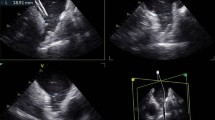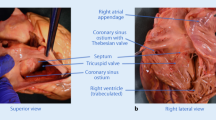Abstract
Intraatrial-conduit Fontan is considered a modification of both extracardiac and lateral-tunnel Fontan. In this study, the patient-specific hemodynamic performance of intraatrial-conduit and lateral-tunnel Fontan with fenestration, considered as conversion templates, was investigated based on the authors’ patient cohort. Pulsatile computational fluid dynamics simulations were performed using patient-specific models of intraatrial-conduit and lateral-tunnel Fontan patients. Real-time “simultaneous” inferior and superior vena cava, pulmonary artery, and fenestration flow waveforms were acquired from ultrasound. Multiple hemodynamic performance indices were investigated, with particular focus on evaluation of the pulsatile flow performance. Power loss inside the lateral-tunnel Fontan appeared to be significantly higher than with the intraatrial-conduit Fontan for patient-specific cardiac output and normalized connection size. Inclusion of the 4-mm fenestration at a 0.24 L/min mean flow resulted in a lower cavopulmonary pressure gradient and less time-averaged power loss for both Fontan connections. Flow structures within the intraatrial conduit were notability more uniform than within the lateral tunnel. Hepatic flow majorly favored the left lung in both surgical connections: conversion from lateral-tunnel to intraatrial-conduit Fontan resulted in better hemodynamics with less power loss, a lower pressure gradient, and fewer stagnant flow zones along the conduit. This patient-specific computational case study demonstrated superior hemodynamics of intraatrial-conduit Fontan over those of lateral-tunnel Fontan with or without fenestration and improved performance after conversion of the lateral tunnel to the intraatrial conduit. The geometry-specific effect of the nonuniform hepatic flow distribution may motivate new rationales for the surgical design.




Similar content being viewed by others
References
Brown JW, Ruzmetov M, Deschner BW, Rodefeld MD, Turrentine MW (2010) Lateral tunnel Fontan in the current era: is it still a good option? Ann Thorac Surg 89:556–562; discussion 562–563
Canter CE (2011) Preventing thrombosis after the Fontan procedure not there yet. J Am Coll Cardiol 58:652–653
Dasi LP, Pekkan K, Katajima HD, Yoganathan AP (2008) Functional analysis of Fontan energy dissipation. J Biomech 41:2246–2252
Dasi LP, Whitehead K, Pekkan K, de Zelicourt D, Sundareswaran K, Kanter K et al (2011) Pulmonary hepatic flow distribution in total cavopulmonary connections: extracardiac versus intracardiac. J Thorac Cardiovasc Surg 141:207–214
de Leval MR, Kilner P, Gewillig M, Bull C (1988) Total cavopulmonary connection: a logical alternative to atriopulmonary connection for complex Fontan operations: experimental studies and early clinical experience. J Thorac Cardiovasc Surg 96:682–695
de Zelicourt DA, Haggerty CM, Sundareswaran KS, Whited BS, Rossignac JR, Kanter KR et al (2011) Individualized computer-based surgical planning to address pulmonary arteriovenous malformations in patients with a single ventricle with an interrupted inferior vena cava and azygous continuation. J Thorac Cardiovasc Surg 141:1170–1177
Dur O, Coskun S, Coskun K, Frakes D, Kara L, Pekkan K (2010) Computer-aided patient-specific coronary artery graft design improvements using CFD-coupled shape optimizer. Cardiovasc Eng Technol 2:35–47
Dur O, DeGroff CG, Keller BB, Pekkan K (2010) Optimization of inflow waveform phase-difference for minimized total cavopulmonary power loss. J Biomech Eng 132:031012
Dur O, Kocyildirim E, Soran O, Wearden P, Morell V, DeGroff CG et al (2011) Pulsatile venous waveform quality affects the conduit performance in functional and “failing” Fontan circulations. Cardiol Young 19:1–12
Fiore AC, Turrentine M, Rodefeld M, Vijay P, Schwartz TL, Virgo KS et al (2007) Fontan operation: a comparison of lateral tunnel with extracardiac conduit. Ann Thorac Surg 83:622–630
Fraser KH (2011) The use of computational fluid dynamics in the development of ventricular assist devices. Med Eng Phys 33:263–280
Hsia TY, Khambadkone S, Redington AN, Migliavacca F, Deanfield JE, de Leval MR (2000) Effects of respiration and gravity on infradiaphragmatic venous flow in normal and Fontan patients. Circulation 102(19 Suppl 3):III148–III153
Hsia T, Khambadkone S, Redington A, de Leval M (2001) Effect of fenestration on the subdiaphragmatic venous hemodynamics in the total cavopulmonary connection. Eur J Cardiothorac Surg 19:785–792
Hsia T, Migliavacca F, Pittaccio S (2004) Computational fluid dynamic study of flow optimization in realistic models of the total cavopulmonary connections. J Surg Res 116:305–313
Itatani K, Miyaji K, Tomoyasu T (2009) Optimal conduit size of the extracardiac Fontan operation based on energy loss and flow stagnation. Ann Thorac Surg 88:565–572; discussion 563–572
Kim SJ, Bae EJ, Lee JY, Lim HG, Lee C, Lee CH (2009) Inclusion of hepatic venous drainage in patients with pulmonary arteriovenous fistulas. Ann Thorac Surg 87:548–554
Klimes K, Abdul-Khaliq H, Ovroutski S, Hui W, Alexi-Meskishvili V et al (2007) Pulmonary and caval blood flow patterns in patients with intracardiac and extracardiac Fontan: a magnetic resonance study. Clin Res Cardiol 96:160–167
Lee SY, Baek JS, Kim GB, Kwon BS, Bae EJ, Noh CI et al (2012) Clinical significance of thrombosis in an intracardiac blind pouch after a Fontan operation. Pediatr Cardiol 33:42–48
Marcelletti C, Corno A, Giannico S, Marino B (1990) Inferior vena cava-pulmonary artery extracardiac conduit: a new form of right heart bypass. J Thorac Cardiovasc Surg 100:228–232
Ono M, Boethig D, Goerler H, Lange M, Westhoff-Bleck M, Breymann T (2006) Surgical repair of anomalous pulmonary venous connection shunting from left atrium to superior vena cava. Eur J Cardiothorac Surg 30:923–929
Pekkan K, Kitajima H, de Zelicourt D, Forbes J, Parks J, Fogel M et al (2005) Total cavopulmonary connection flow with functional left pulmonary artery stenosis: angioplasty and fenestration in vitro. Circulation 112:3264–3271
Pekkan K, de Zelicourt D, Ge L, Sotiropoulos F, Frakes D, Fogel DM et al (2005) Physics-driven CFD modeling of complex anatomical cardiovascular flows: a TCPC case study. Ann Biomed Eng 33:284–300
Pekkan K, Dasi LP, de Zelicourt D, Sundareswaran KS, Fogel MA, Kanter KR et al (2009) Hemodynamic performance of stage 2 univentricular reconstruction: Glenn vs hemi-Fontan templates. Ann Biomed Eng 37:50–63
Ruiz E, Guerrero R, d’Udekem Y, Brizard C (2009) A technique of fenestration for extracardiac Fontan with long-term patency. Eur J Cardiothorac Surg 36:200–202
Salazar JD, Zafar F, Siddiqui K, Coleman RD, Morales DL, Heinle JS, Rossano JW, Mossad EB, Fraser CD Jr (2010) Fenestration during Fontan palliation: now the exception instead of the rule. J Thorac Cardiovasc Surg 140:129–136
Varma C, Warr M, Hendler A, Paul N, Webb G, Therrien J (2003) Prevalence of “silent” pulmonary emboli in adults after the Fontan operation. J Am Coll Cardiol 41:2252–2258
Walker P, Howe T, Davies R, Fisher J, Watterson K (2000) Distribution of hepatic venous blood in the total cavopulmonary connection: an in vitro study. Eur J Cardiothorac Surg 17:658–665
Whitehead KK, Pekkan K, Kitajima HD, Paridon SM, Yoganathan AP, Fogel MA (2007) Nonlinear power loss during exercise in single-ventricle patients after the Fontan: insights from computational fluid dynamics. Circulation 11:I165–I171
Whitehead KK, Sundareswaran KS, Parks WJ, Harris MA, Yoganathan AP, Fogel MA (2009) Blood flow distribution in a large series of patients having the Fontan operation: a cardiac magnetic resonance velocity mapping study. J Thorac Cardiovasc Surg 138:96–102
Yoganathan AP (2005) Flow in prothetic heart valves, state-of-the-art and future directions. ABME 33:1689–1694
Acknowledgments
This study was supported in part by Carnegie Mellon University, the National Natural Science Foundation of China (Grant 81070133), the Science and Technology Commission of Shanghai Municipality (Grant 114119a8400), and the Pittsburgh Supercomputing Center.
Author information
Authors and Affiliations
Corresponding authors
Rights and permissions
About this article
Cite this article
Hong, H., Dur, O., Zhang, H. et al. Fontan Conversion Templates: Patient-Specific Hemodynamic Performance of the Lateral Tunnel Versus the Intraatrial Conduit With Fenestration. Pediatr Cardiol 34, 1447–1454 (2013). https://doi.org/10.1007/s00246-013-0669-5
Received:
Accepted:
Published:
Issue Date:
DOI: https://doi.org/10.1007/s00246-013-0669-5




